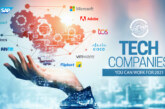The development of the FinTech industry since the outbreak of the pandemic has gone through major changes. Today, the global FinTech market is witnessing an exponential growth and is expected to reach USD 31.5 billion by 2026, which is four times higher than the last six years. Here is a list of top ten technologies that will be trending in 2022.
- The internet of things: FinTech companies are rapidly employing Internet of Things (IoT) to gather business-friendly insights on their customers and make more informed decisions accordingly.
- Open banking: Open banking, or open API, works on the principle of providing the bank’s client data to third parties with the consent of the owner. It helps bank users as transactions become more efficient.
- Biometric authentication: Biometric authentication is considered to be more secure than regular passwords and PINs. Users are not required to insert multiple passwords everywhere; instead, information can be accessed with a thumb impression or an iris scanner in real-time.
- RegTech: RegTech is a platform that helps organizations in complying with complex industry regulations. Monitoring, reporting, and compliance can be done with the help of RegTech technology.
- Artificial Intelligence: Smart algorithms improve the operations of banks, credit, and insurance companies. Artificial intelligence analyses the typical behavior of users. If a scammer gains access to the platform, the AI notices the aberrant behavior, and alerts the clients and banks of the threat.
- Cloud computing: Cloud computing is the delivery of computing services such as database, servers, storage, and analytics, among others. With the help of this technology, financial companies get scalable storage and large computing power at competitive prices.
- Blockchain: Blockchain establishes procedures within a banking system and helps to keep an automatic record of data such as: how the money entered the system, who sent it, how it was used, and what it was spent on.
- Virtual cards: A virtual card guarantees safe payments for goods and services on the World Wide Web. The customer can pay for goods and services with their virtual card. The payment can be done without feeding information of the physical bank card. Only a 16-digit number of a temporary digital analogue is required.
- Voice payments: Voice biometrics is becoming a new method for payment of goods, checking the balance of voice commands, among other things. The technology allows the users to request a transaction verbally. Manual data entry is not required when you have this technology.
- Robotic process automation (RPA): Robot process automation (RPA) is a type of technology that eases the process of building, deploying, and managing software robots that emulate the actions of a human by interacting with digital systems and software. The technology is expected to garner a 400 per cent revenue growth by 2023.




